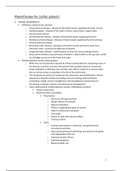Physiotherapy for cardiac patients
1. Cardiac rehabilitation
• Definition cardiovascular diseases
o Coronary heart disease = disease of the blood vessels supplying the heart muscle
o Cardiomyopathy = disease of the heart muscles, heart failure, hypertrophy
o Valvular heart disease
o Cerebrovascular disease = disease of the blood vessels supplying the brain
o Peripheral arterial disease = disease of blood vessels supplying the arms and legs
o Primary electrical disease
o Rheumatic heart disease = damage to the heart muscle and heart valves from
rheumatic fever, caused by stretptococcal bacteria
o Congenital heart disease = malformations of heart structure existing at birth
o Deep vein thrombosis and pulmonary embolism = blood cloths in the leg veins, which
can dislodge and move to the heart and lungs
• Multidisciplinary cardiac rehab program
o WHO: The sum of activities required to influence favourable the underlying cause of
the disease, as well as to ensure the patients best possible physical, mental and
social conditions so that they may, by their own efforts, preserve or resume when
lost, as normal a place as possible in the life of the community.
o The European association of cardiovascular prevention and rehabilitation: Patient
assessment, physical activity counselling, exercise training, diet/nutritional
counselling, weight control management, lipid management, blood pressure
monitoring, smoking cessation and psychosocial management.
o Topics addressed by multidisciplinary cardiac rehabilitation program
▪ Patient assessment
▪ Physical activity counselling
• Prescription
o Assess the PA type and level
o Explain effects of inactivity
o Explore motivation
o Advise on appropriate types of activity
o Help to achieve personal goals
o Encourage
o Advice to cope with adverse effects
o Training volume
• Goals
o Increase participation in domestic, occupational and
recreational activities
o Improved psychosocial well-being, prevention of disability
and independent self-care
o Improved aerobic fitness
o Improved prognosis
o Reduced frailty risk
1
, ▪ Exercise training
• Prescription
o Individualized approach
o According to the FITT+T model
▪ Frequency, Intensity, Time (duration), Type of
exercise
▪ T = referring to when exercise is performed in
relation to meal time
o Organize exercise training
• Goals
o Increase aerobic fitness and enhanced flexibility, muscular
endurance, strength and coordination
o Reduction of symptoms, attenuated physiological response
to physical challenges and improved psycho-social well being
o Decrease in cardiovascular risk and improvement of
prognosis
▪ Diet/nutritional counseling
▪ Weight control management
▪ Lipid management
▪ Blood pressure management
▪ Smoking cessation
▪ Psychosocial management
▪ Evaluation of the program results and structured follow-up
o Personal needed for the program
▪ Dietician
• Weight loss, cholesterol, diabetes, healthy diet
▪ Cardiologist
• Follow up of the heart disease, complaints and medication
• Attention for correction of risk factors: cholesterol, smoking
cessation, obesity, high blood pressure,…
▪ Psychological counselor
• Reducing stress and anxiety, depression, coping strategies for
chronic disease,…
▪ Social worker
• Social security, resuming work, handicap, financial issues,…
▪ Physiotherapist
• Improving the general and physical condition after surgery or disease
• Guiding the patient to a healthy life style/movement
o In daily life
o Recreational sports
o Giving sportsmen a healthy framework in which sports are
safe
• Improvement of VO2max
2
, • Survival and exercise
Physical intensity METs Watt (70 kg) Kcal/min
Low <3 < 40 <4
Medium 3-6 40-100 4-8
High >6 >100 >8
• Conditions CR in Belgium
o The patient has to start multidisciplinary cardiac rehabilitation during his stay in a
hospital with an official cardiac rehab program
▪ Acute myocardial infarction
▪ Coronary artery bypass grafting
▪ Therapeutic endovascular procedure on the heart and/or coronary arteries
(medical imaging)
▪ Surgery for a congenital or developed abnormality of the heart or for a
valvular disease
▪ Heart or lung transplantation
▪ Cardiomyopathy with dysfunction of the left ventricle
o 45 multidisciplinary sessions are reimbursed (max 6 months after the index event)
• Cardiac rehab practical organization
o Multidisciplinary hospital driven program
▪ Phase 1: in hospital
▪ Phase 2: ambulant rehabilitation (hospital), groups
▪ Phase 3: rehabilitation in an “out patient” setting (coaching and guidance in
a sports club, a fitness program,…)
o Cardiac rehabilitation in the home setting/individual therapist
▪ Phase 2: ambulant rehabilitation (individual)
▪ Phase 3: guidance to a sports club, fitness program or other types of physical
activity
3
, 2. Work and sports in cardiac disease
• ESC guidelines after myocardial infarction
o Return to work after AMI represents an important indicator of recovery.
o Younger women in particular are at greater risk of not returning to work, given
evidence of their worse recovery after MI than similarly aged men.
o Decisions should be individualized, based on LV function, completeness of
revascularization and rhythm control and the job characteristics.
o Extended sick leave is usually not beneficial and light-to-moderate physical activity
after discharge should be encouraged. Sexual activity can be resumed early if
adjusted to physical ability.
• Identification of cardiovascular disease and risk stratification in individuals participating in
recreational and competitive sports
o Definitions of recreational and competitive athletes
o Exercise related major adverse cardiovascular events
o Incidence of sudden cardiac death in athletes
o Etiology of sudden cardiac death during exercise
o Screening modalities for cardiovascular disease in young athletes
o Screening for cardiovascular disease in older athletes
o Zie PPT A. Vorlat dia 22-26
• Work/sports
o Physical aspects of the job/sport
o Psychological factors/anxiety/stress
o Working in shifts, night time,…
4




